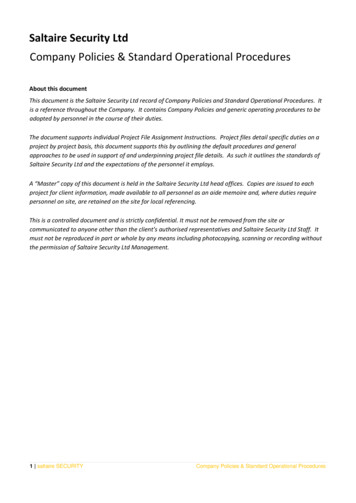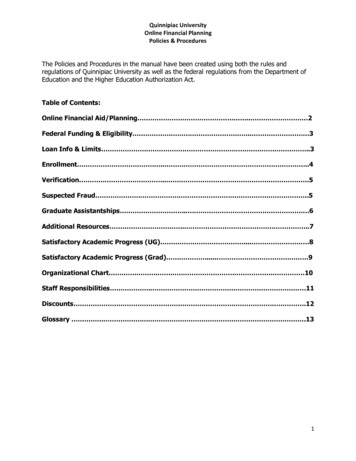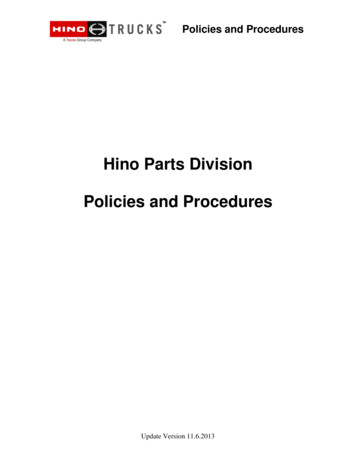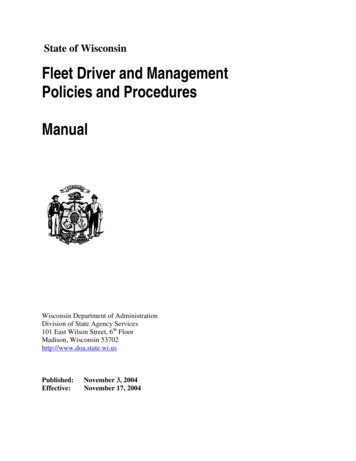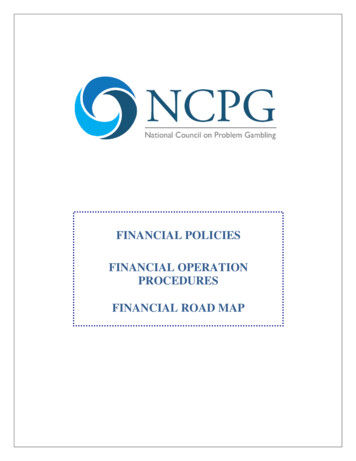
Transcription
FINANCIAL POLICIESFINANCIAL OPERATIONPROCEDURESFINANCIAL ROAD MAP
FINANCIAL POLICIES
TABLE OF CONTENTSFINANCIAL POLICIES.GENERAL PURPOSE . 1Financial StatementsPresentation of Financial StatementsFinancial Responsibilities & OperationsTHE FINANCE COMMITTEE. 2ACCOUNTING & RECORD KEEPING . 3FISCAL YEAR OF ORGANIZATION . 4LEASES AND OTHER CONTRACTUAL AGRREMENTS . 5Notes, Loans, Etc.Revenue Goals and ReportsBUDGETING PROCESS . 6Event BudgetsAuditInternal Financial StatementsINCOME PROCEDURES . 7-11RevenueFINANCIAL OPERATION PROCEDURES .INTERNAL CONTROL STRUCTURE . 12-13PROCESSING CASH RECEIPTS AND REVENUE . 14-15PROCESSING PURCHASES . 16-18PROCESSING CASH DISBURSEMENTS . 19-20MANAGEMENT OF CASH . 21PAYROLL . 22-25FINANCIAL ROAD MAP .DEPOSITS . 26Billing ClientsCOLLECTING MONIES DUE . 27Board of Directors ReimbursementEmployee ReimbursementsPAYING VENDORS . 28Coding Expenses to Another Manager’s P & LCOMPANY CREDIT CARD . 29Month End Process ExceptionsMonthly Program-Finance MeetingsPETTY CASH . 30Budgets and BudgetingCODING EXPENSES: CHART OF ACCOUNTS . 31ChecksContract Signature AuthorityFORMS . .32
1.GENERAL PURPOSEThe purpose of this Financial Management policy is to establish guidelines for theBoard of Directors and the National Council on Problem Gambling staff aboutstandards and procedures to be applied when developing financial goals andobjectives, making financial decisions and reporting the financial status of theorganization. In addition, these policies will provide guidelines to allow for aneffective management of the organization’s funds. The National Council on ProblemGambling hereinafter referred to as the (“NCPG”) is a 501(c) 3 nonprofit organization.NCPG’s mission is to increase public awareness of pathological gambling, ensurethe widespread availability of treatment for problem gamblers and their families,and to encourage research and programs for prevention and education.2.FINANCIAL STATEMENTSNCPG’s financial statements shall be prepared on the accrual basis in accordance withGenerally Accepted Accounting Principles (“GAAP”), and more specifically inaccordance with standards of accounting and reporting established for non-profitorganizations.3.PRESENTATION OF FINANCIAL STATEMENTSThe presentation of the Financial Statements shall follow the recommendation of theFinancial Accounting Standards No. 117, “Financial Statements of Not-For-ProfitOrganizations” (SFAS No. 117).4.FINANCIAL RESPONSIBILITIES & OPERATIONSThe Board of Directors oversees the general financial administration of the NCPG andrelies on the Executive Director and Business Manager for the day to day operationsand financial decisions. The Board delegates this oversight responsibility to theTreasurer of the Board and the Finance Committee of which the Treasurer is Chair.This responsibility is shared through delegation with the Executive Director of NCPGand the Business Manager.The Business Manager, together with the assistance of his/her staff, is responsible forpreparing financial reports for the executive director, board officers, and outsideagencies.The Business Manager oversees the following:Budget AdministrationRisk ManagementAccounting OperationsHuman ResourcesAccounts PayableFixed AssetsContracts and Accounting1 Page
PayrollTaxation and ReportingCash DisbursementsAccounts ReceivablePayrollFinancial Statement ProcessingExternal Reporting of Financial InformationBank ReconciliationsReconciliation of Sub-LedgersCompliance with Government Reporting RequirementsAnnual AuditLeasesInsuranceFinancial Reporting/General Accounting/AuditingIt is the responsibility of the Board of Directors to formulate financial policies,delegate administration of such policies to staff, and review operations and activitieson a periodic basis.Organization ChartExecutiveDirectorKeith WhyteBarbara RollinsDirector of Development& MembershipJuan A. LopezBusiness ManagerFinance/HR&ComplianceJocelyn WilcoxProgram AdministratorMelissa EckenrodeOffice Manager5.THE FINANCE COMMITTEEThe Finance Committee shall be responsible for the oversight and coordination of thefollowing: Annual budget presentation for Board approval Presentation of periodic financial statements Management of investments Selection of the outside auditors Annual financial report Internal controls Financial policies2 Page
The Treasurer of NCPG shall serve as the Chair of the Finance Committee. TheFinance Committee is staffed by the Business Manager and other staff as assigned.The long-term financial objectives of NCPG are reviewed and approved by theFinance Committee following the recommendations of the Executive Director and theassigned staff.Roles and responsibilities for Finance Head vs. Executive Director vs. BoardCommitteeThe general and daily financial management and reporting of NCPG are implementedby the Executive Director and the Business Manager. NCPG’s Executive Director actsas the primary fiscal agent, implementing all financial policies and procedures. Theassigned Business Manger recommends expenditures and revenue objectives forNCPG in accordance with the Board-approved long-term plans, and develops andmaintains the annual budget in cooperation with the management team and otherBoard committees.6.ACCOUNTING AND RECORD-KEEPINGGeneral Ledger and Chart of AccountsIntroductionThe general ledger is defined as a group of accounts that supports the informationshown in the major financial statements. The general ledger is used to accumulate allfinancial transactions of the National Council on Problem Gambling (NCPG) and issupported by subsidiary ledgers that provide details for certain accounts in the generalledger. The general ledger is the foundation for the accumulation of data and reports.NCPG uses QuickBooks Premier Nonprofit Edition to record accounting transactions.QuickBooks provides for separate, self-balancing sets of accounts in accordance withgenerally accepted accounting principles and procedures for Nonprofits. Thisaccounting system was purchased from Intuit and is updated according to the needs ofthe organization and within budgetary limits.PolicyNCPG’s policy is to establish a chart of accounts which accumulates all financialtransactions of the organization. The chart of accounts includes fund/account codesfor general ledger activity and organization/account codes for subsidiary ledgerentries.Chart of AccountsThe chart of accounts is the framework for the general ledger system, and therefore thebasis for NCPG’s accounting system. The chart of accounts consists of account titlesand account numbers assigned to the titles. General ledger accounts are used toaccumulate transactions and the impact of these transactions on each asset, liability,net asset, revenue, expense and gain and loss.NCPG’s chart of accounts is comprised of six types of accounts:3 Page
1.2.3.4.5.6.AssetsLiabilitiesNet AssetsRevenuesExpensesGains and LossesDistribution of Chart of AccountsAll NCPG employees involved with account coding responsibilities or budgetaryresponsibilities will be issued a current chart of accounts. On a monthly basis, as thechart of accounts is revised, an updated copy is distributed to these individuals.Control of Chart of AccountsNCPG’s chart of accounts is monitored and controlled by the Business Manager.Responsibilities include the handling of all account maintenance, such as additionsand deletions. Any additions or deletions of accounts should be approved by theFinance Committee or Executive Director, who ensures that the chart of accounts isconsistent with the organizational structure of NCPG and meets the needs of eachdepartment.Fund Format – General LedgerEach six-digit general ledger fund account always starts with zero and is followed byfive digits which identify the ledger’s purpose.General ledger funds consist istrationNational ConferenceHelplinePublic Awareness (Advocacy & NPGAW)Counselor CertificationMembershipA complete list of account codes is available by generating the QuickBooks Chart ofAccounts Report. The report also shows how codes are grouped and totaled forvarious reporting purposes.7.FISCAL YEAR OF ORGANIZATIONNCPG’s fiscal year begins January 1st and ends December 31st. Any changes to thefiscal year of the organization must be ratified by majority votes of NCPG’s Board ofDirectors.The Business Manager, with the oversight of the Finance Committee and ExecutiveDirector, shall have the direct responsibility for the accuracy of NCPG accountingrecords.4 Page
The Business Manager is responsible for the preparation of the Chart of Accounts,Reporting Formats, Accounts Payable Processing, Payroll input and Payrollprocessing, Cash Receipts input, Journal Entries for General Ledger, Form 1099reporting, Form 5500 reporting, and Form 990 reporting as well as BankReconciliations.8.LEASES AND OTHER CONTRACTUAL AGREEMENTSNCPG conducts its operations from a leased office suite. Leases and other contractualagreements are negotiated by the Business Manager and executed with the approvaland signature of the Executive Director.All leases shall be approved by the Executive Director and the Business Manager andsubsequently presented to the Finance Committee for ratification through thebudgeting process. The following rules also apply: 9.Leases will correspond to the fiscal year whenever possible.Copies of all leases will be maintained in the assigned Business Manager’s office.The Executive Director is authorized to develop and enter into contractualagreements with vendors, bankers, and third parties for the purpose of NCPG’sgeneral operations.The Finance Committee shall review such agreements and make recommendationswhen necessary.NOTES, LOANS, ETC.All notes, loans and other indebtedness to be contracted in the name of the NCPG(except open accounts and all other routine banking transactions), shall require thesignatures of the Chair of the Board, or the Treasurer of the Board and the signature ofthe Executive Director, unless otherwise specified by the Board or established in thepresent management policies and procedures.10.REVENUE GOALS AND REPORTSThe responsibility for reaching NCPG’s budgeted revenue goals on a yearly basis isshared by the Executive Director and the Board of Directors. The Executive Director,in conjunction with the Director of Development and Membership, the ProgramAdministrator, and the Business Manager, develops and proposes revenue goals andsubmits them to the appropriate Committees for review and recommendations prior tosubmitting them to the Board for discussion, and eventual development and approvalof the annual budget.With the assistance of the Business Manager, the Director of Development andMembership prepares a report on the financial status of fundraising activities for eachDevelopment Committee meeting and on the financial status of membership activitiesfor each Membership Committee meeting. Similarly, the Program Administratorprepares a report on the financial status and activities of program activities for eachapplicable Committee.The Finance Committee reviews monthly revenues and expenditures and if necessarymakes recommendations to the Board and the Executive Director of the NCPG.5 Page
The Finance Committee and Executive Director shall continuously plan for the longterm financial stability of the organization in accordance with the long-term planswhich will be reviewed periodically, and adjusted when necessary.The Finance Committee shall use due diligence in overseeing the investments ofNCPG funds, by establishing and monitoring an investment strategy that gives properrecognition to risk and return.11.BUDGETING PROCESSThe NCPG Executive Director, the Business Manager, and the Treasurer shall beresponsible for presenting to the Finance Committee and other Board Committees anannual operating budget draft sixty (60) days prior to the end of the fiscal year and aproposed budget thirty (30) days prior to its submission to the Board of Directors.The Executive Director and the Business Manager in conjunction with themanagement team will coordinate the internal preparation of the budget draft, whichwill be then presented to the appropriate committees for review. Each staff membershall solicit budget requests and recommendations from the various Board committeesfor which they are liaison. The Executive Director and the Business Manager shallconsider these recommendations when creating the annual budget. The FinanceCommittee shall review and approve the recommended budget revenues andexpenditures for the fiscal year budget, and submit the final budget for approval to theBoard of Directors.12.EVENT BUDGETSAll of the NCPG’s special events shall require the preparation of a budget. An eventbudget shall be prepared by the Staff member(s) responsible for the event andsubmitted to the Business Manager prior to the implementation of the event. Eventexpenditure advances will be provided upon the approval of the event budget. TheAnnual Conference Budget will be developed by the Executive Director, BusinessManager and other committees or staff members as requested.13.AUDITNCPG will have an audit of its financial statements completed annually by a firm ofIndependent Certified Public Accountants. The fiscal audited year shall be January 1through December 31 of each year.The Executive Director and the Business Manager shall have direct responsibility inoverseeing the implementation of the Annual Financial Audit.The Executive Director and the Business Manager shall recommend to the FinanceCommittee for approval the selection of a firm to perform the annual audit. Inaddition, the Chairman of the Finance Committee and the Finance Committee shallassist when necessary in the audit preparation, and report the final results to the Boardof Directors. A representative of the audit firm shall be invited to attend the annual6 Page
presentation to the Finance Committee, and shall be required to make a presentation tothe Board if the audit report is other than unqualified, or if the auditor’s report materialweaknesses in internal controls or reportable conditions.14.INTERNAL FINANCIAL STATEMENTSThe Business Manager shall prepare and present Monthly Financial Statements in aformat approved by the Finance Committee. The Financial Statements shall includeinformation about all NCPG’s funds and cash position as of the end of each month andquarter. The Financial Statements will be submitted by the Business Manager to theExecutive Director; and by the Executive Director to the Treasurer on a monthly basis by the15th of the month for the preceding month. The Financial Statements shall also be submittedto the Board of Directors on a quarterly basis, 30 days before the close of the quarter, or asdirected by the President of the Board of Directors.The Finance Committee will hold a conference call the following week to review financials.Monthly meetings will not be held March, June, September and December while quarterlyinformation is compiled. Quarterly: NCPG will provide quarterly reports to Treasurer 45days after the close of the quarter. The Finance Committee will meet via conference call toreview the following week.The Business Manager shall also prepare Monthly reports for the Program Administrator andDirector of Development and Membership, including a P & L statement for reviewing theaccuracy and propriety of revenue and expense transactions made to the NCPG accounts forwhich they have responsibility. These reports shall show monthly and year-to-date revenues,expenditures, and net revenues by account. Additionally, they present the original annualbudget and revised budgets for these accounts.15.INCOME PROCEDURESAll contributions shall be recorded in accordance with GAAP, with specific attentionto standards FASB 116 and 117 and/or subsequent standards. Contributions arerecorded as pledged or received in accordance with FASB 116, and must be creditedto the appropriate revenue lines as presented in the annual budget and coded with theappropriate account number as designated in NCPG’s Chart of Accounts.All checks received by the NCPG’s shall be recorded and deposited with due diligencein the appropriate accounts by the assigned staff.Cash and checks exceeding One Thousand Dollars ( 1,000) shall be the object of dualcontrol executed by the receiver and the assigned staff for finance or any two (2) otherauthorized staff members.16.REVENUERevenue Recognition Policies7 Page
NCPG receives revenue from several revenue streams or purposes. Revenue for eachof these is recognized in the financial statements in the following manner:a. Certificationb. Conferencec. Continuing Educationd. Contributed (unrestricted or not designated)e. Helplinef. Membershipg. Product Saleh. Public Awareness & Trainingi. Earned Income for Servicesj. MiscellaneousDefinitionsThe following definitions shall apply with respect to the policies described in thissection:Contribution –Corporate Governance and Donations PolicyThe National Council on Problem Gambling will not accept any donations,membership fees or contributions with any formal or informal restrictions, limitationsor covenants placed on their use or upon the policies and programs of the NationalCouncil. All monetary and in-kind support will be used exclusively to support themission of the NCPG. Acceptance of a donation by NCPG establishes noresponsibility or relationship to the donor except for financial disclosure requirements,including IRS reporting. Donors are not permitted to utilize the NCPG name or logowithout permission. All potential donors will be informed of this policy prior to theirdonation.Promise to Give – A written or oral agreement to contribute cash or other assets toNCPG.Distinguishing Contributions from Exchange TransactionsNCPG receives income in the form of contributions, revenue from exchangetransactions, and income from activities with characteristics of both contributions andexchange transactions. NCPG considers the following criteria, and any other relevant8 Page
factors, in determining whether income will be accounted for as contribution income,exchange transaction revenue, or both:1. NCPG’s intent in soliciting the asset, as stated in the accompanying materials;2. The expressed intent of the entity or person providing resources to NCPG (i.e.does the resource provider state its intent is to support NCPG’s programs orthat it anticipates specified benefits in exchange);3. Whether the method of delivery of the asset is specified by the resourceprovider (exchange transactions) or is at the discretion of NCPG(contribution);4. Whether payment received by NCPG is determined by the resource provider(contribution) or is equal to the value of the assets/services provided by NCPG,or the cost of those assets plus a markup (exchange transaction);5. Whether there are provisions for penalties (due to nonperformance) beyond theamount of payment (exchange transaction) or whether penalties are limited tothe delivery of assets already produced and return of unspent funds(contribution); and6. Whether assets are to be delivered by NCPG to individuals or organizationsother than the resource provider (contribution) or whether they are delivereddirectly to the resource provider or to individuals or organizations closelyconnected to the resource provider.Accounting for ContributionsNCPG recognizes contribution income in the period in which NCPG receivesunrestricted assets in nonreciprocal transfers, or unconditional promises of futurenonreciprocal asset transfers.Unconditional promises to give shall be recorded as assets and increases intemporarily restricted net assets (contribution income) of NCPG in the period thatNCPG receives evidence that a promise to support the organization has been made.Unconditional promises to give that are to be collected within one year shall berecorded at their face value, less any reserve for uncollectible promises, as estimatedby management.Unconditional promises to give that are collectible over time periods in excess of oneyear shall be recorded at their discounted net present value. Accretion of discount onsuch promises to give shall be recorded as contribution income in each period leadingup to the due date of the promise to give. The interest rate that shall be used incalculating net present values of unconditional promises to give is the risk-free rate ofreturn, compiled based on an average of rates applicable to the current year.When support in the form of volunteer labor is received, NCPG shall recordcontribution income and assets or expenses, if one of the following two criteria is met:1. The contributed service creates or enhances a non-financial asset (such as abuilding or equipment), or2. The contributed service possesses all three of the following characteristics:a. It is the type of service that would typically need to be purchased byNCPG, if it had not been contributed,9 Page
b. It requires specialized skills (i.e. formal training in a trade orprofession), andc. It is provided by an individual possessing those specialized skills.Contributed services that meet either one of the two preceding criteria shall berecorded at the fair market value of the service rendered.Contributions of non-cash assets (artifacts, food, clothing, etc.) shall be recorded atfair market value as of the date of the gift. The value assigned to such non-cash assetsshall be determined by NCPG’s Business Manager. Values provided by donors shallbe considered in establishing these valuations, however, the final value used foraccounting purposes shall be the value determined by NCPG. Further, it is the policyof NCPG not to certify any valuation of non-cash assets provided by donors. Ifnecessary, a third party professional evaluator may be called upon by the ExecutiveDirector to establish a valuation.Receipts and DisclosuresNCPG and its donors are subject to certain disclosure and reporting requirementsimposed under the Internal Revenue Code and the underlying Regulations. To complywith those rules, NCPG shall adhere to the following guidelines with respect tocontributions received by the organization.For any separate contribution received by NCPG, it shall provide a receipt to thedonor. The receipt shall be prepared by the Business Office. All receipts prepared byNCPG shall include the following information:1. The amount of cash received and/or a description of any non-cash propertyreceived;2. A statement of whether NCPG provided any goods or services to the donor inconsideration, in whole or in part, for any of the cash or property received fromthe donor, and3. If any goods or services were provided to the donor by NCPG, a descriptionand good faith estimate of the value of those goods or services.Disclosures of Promises to GiveAs stated earlier, NCPG shall record an asset and an increase in net assets forunconditional promises to give. In addition, in connection with its annual financialstatements, NCPG shall prepare a schedule of unconditional promises to give thatdiscloses the annual amounts to be collected in each of the next five years, and a totalamount due thereafter, less the amount representing interest as a result of discountinglong-term promises to give to net present value.In connection with conditional promises to give, which shall not be recorded on thefinancial statements, NCPG shall nonetheless prepare a similar schedule of futurepayments for disclosure in the organization’s annual financial statements.Gift Acceptance Policy10 P a g e
NCPG may accept charitable contributions of all types of assets from any type ofdonor, with the following exceptions:1. Contributions of non-liquid assets or assets possessing legal or othercharacteristics rendering the asset difficult to sell or convert to liquid assets, asdetermined by the Executive Director and the Business Manager.2. Contributions with donor-imposed restrictions that provide excessive control tothe donor over future uses of the donated asset(s), as determined by theExecutive Director.3. Contributions with donor-imposed restrictions that violate or involve uses thatgo beyond NCPG’s current mission statement and tax-exempt purposes, asdetermined by the Executive Director; and4. Contributions from donors involved in businesses or activities that are deemedinconsistent with NCPG’s mission.11 P a g e
FINANCIAL OPERATIONPROCEDURES
FINANCIAL OPERATION PROCEDURES1.INTERNAL CONTROL STRUCTUREThe Executive Director and the Business Manager will have the primary responsibility ofexecuting all financial matters. All members of the fiscal management team will worktogether to make certain that all financial matters of the organization are addressed withcare, integrity, and in the best interests of the organization.The Executive Director is responsible for administering adopted policies and ensuringcompliance with procedures that have been approved by the Board of Trustees.Exceptions to written policies may only be made with the prior approval of the FinanceCommittee. Changes or amendments to these policies shall be conducted by the FinanceCommittee and approved by the Board of Trustees at least once a year.Any violation of these policies and procedures is considered to be cause for termination orremoval and, depending upon the nature of the infraction, civil and/or criminalprosecution.Internal Control ProceduresNCPG has adopted a number of internal financial controls. These procedures are set up tostrengthen NCPG’s internal control structure in order to safeguard the organization’sassets. The internal financial controls consist of the following:Segregation of Duties: A hierarchical structure of authority and responsibility has beendeveloped at NCPG. Tasks are divided and allocated to guard against one individualhaving the ability to make an accounting error (either knowingly or unknowingly). Thisprotects the organization from any potential fraud or misappropriation of funds. Insituations where there are an insufficient number of employees to achieve this because ofbudget constraints, a compensating control has been created at the organization.Restricted Access: Physical access to valuable and moveable assets is restricted toauthorized personnel.Document Control: In order to ensure that all documents are captured by the accountingsystem, all documents must be initialed and dated when recorded and then filedappropriately.Records Retention: To provide an accurate and auditable record of all financial transactions,the organization’s books, records, and accounts are maintained in conformity with generallyaccepted accounting principles. Records will be maintained for the periods sufficient tosatisfy IRS regulations and other legal needs as may be determined. Record retentionrequirements are reviewed annually with legal counsel and independent auditors todetermine any necessary changes.Processing Controls: These are designed to identify any errors before they are posted tothe general ledger. Common processing controls are the following: (1) Source documentmatching; (2) Clerical accuracy of documents; and (3) General ledger account codechecking.12 P a g e
Reconciliation Controls: These are designed to identify any errors after transactions havebeen posted and the general ledger has been run. The process involves reconcilingselected general ledger control accounts to subsidiary ledgers. Reconciliation is completedby the Business Manager and approved by the
Financial Reporting/General Accounting/Auditing It is the responsibility of the Board of Directors to formulate financial policies, delegate administration of such policies to staff, and review operations and activities on a pe

